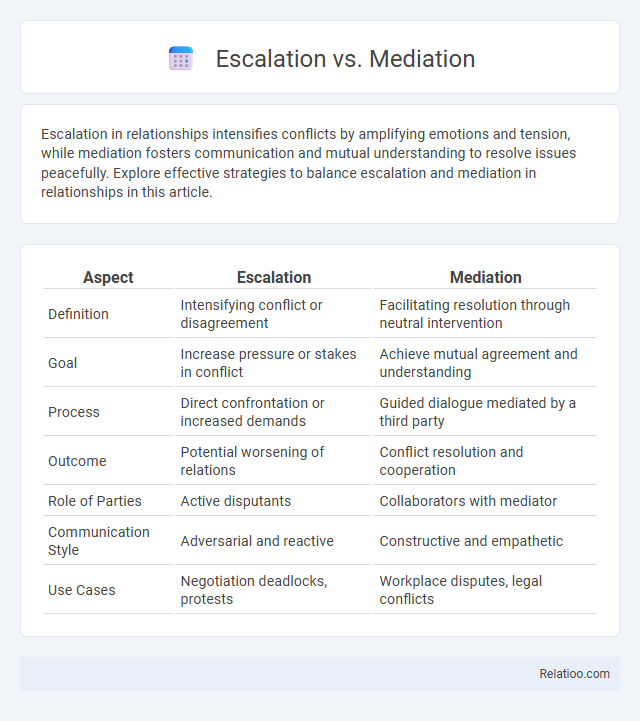Escalation in relationships intensifies conflicts by amplifying emotions and tension, while mediation fosters communication and mutual understanding to resolve issues peacefully. Explore effective strategies to balance escalation and mediation in relationships in this article.
Table of Comparison
| Aspect | Escalation | Mediation |
|---|---|---|
| Definition | Intensifying conflict or disagreement | Facilitating resolution through neutral intervention |
| Goal | Increase pressure or stakes in conflict | Achieve mutual agreement and understanding |
| Process | Direct confrontation or increased demands | Guided dialogue mediated by a third party |
| Outcome | Potential worsening of relations | Conflict resolution and cooperation |
| Role of Parties | Active disputants | Collaborators with mediator |
| Communication Style | Adversarial and reactive | Constructive and empathetic |
| Use Cases | Negotiation deadlocks, protests | Workplace disputes, legal conflicts |
Understanding Escalation: Definition and Key Concepts
Escalation involves the process of increasing the priority or severity of an issue to ensure timely resolution, often by involving higher levels of management or specialized teams. Key concepts include recognizing triggers for escalation, clear communication channels, and well-defined escalation paths to avoid delays in addressing critical problems. Understanding escalation helps you manage conflicts or operational challenges effectively by ensuring issues are addressed at the appropriate level promptly.
What is Mediation? An Overview
Mediation is a structured, confidential process where a neutral third party helps disputing individuals or groups communicate and negotiate to reach a mutually acceptable solution. Unlike escalation, which involves raising the issue to higher authority levels for resolution, mediation emphasizes collaboration and voluntary agreement without imposing decisions. Your active participation in mediation can lead to faster, more flexible, and cost-effective conflict resolution compared to formal escalation processes.
Escalation vs Mediation: Core Differences
Escalation involves transferring an issue to a higher authority or more specialized team to achieve resolution, typically in hierarchical structures or customer service settings. Mediation focuses on facilitating communication between conflicting parties to reach a mutually agreeable solution without external imposition, emphasizing collaboration and neutrality. The core difference lies in escalation's authority-driven approach versus mediation's collaborative, impartial conflict resolution process.
When to Choose Escalation in Conflict Resolution
You should choose escalation in conflict resolution when initial discussions or mediation fail to resolve a dispute and the issue requires higher authority intervention to enforce a decision or policy. Escalation is appropriate for urgent conflicts needing immediate action or when parties remain deadlocked despite negotiation efforts. Selecting escalation ensures a structured approach to resolve disputes that cannot be managed at lower levels.
The Benefits of Mediation in Dispute Management
Mediation offers a structured yet flexible approach to dispute management, allowing Your parties to collaboratively reach a mutually acceptable resolution. Unlike escalation, which often prolongs conflict and increases costs, mediation promotes open communication and preserves business relationships by fostering understanding. The benefits of mediation include reduced time and expenses, confidential proceedings, and enhanced control over the outcome, making it a preferred method in resolving disputes efficiently.
Risks and Downsides of Escalation
Escalation often carries significant risks such as increased conflict intensity, strained relationships, and potential loss of collaboration, which can hinder resolution efforts. Unlike mediation, which promotes mutual understanding and constructive dialogue, escalation may escalate emotions and lead to rigid positions, reducing the likelihood of a positive outcome. Your choice to escalate should consider these downsides carefully to avoid damaging long-term partnerships and worsening disputes.
Mediation Techniques for Effective Communication
Mediation techniques for effective communication focus on active listening, empathy, and neutral facilitation to resolve conflicts without escalation. You can promote understanding by encouraging open dialogue and helping parties identify common interests. These strategies reduce tension and foster cooperation, preventing disputes from intensifying and leading to constructive outcomes.
Case Studies: Escalation Outcomes vs Mediation Results
Case studies reveal that escalation often leads to prolonged resolution times and increased costs, whereas mediation results in higher rates of mutually agreeable solutions and preserved relationships. Your choice between escalation and mediation affects not only the outcome but also long-term stakeholder satisfaction and conflict recurrence. Data indicates mediation reduces litigation by up to 40%, emphasizing its efficiency compared to traditional escalation processes.
Decision Criteria: Escalation or Mediation?
Decision criteria for choosing escalation or mediation depend on conflict complexity, urgency, and parties' willingness to cooperate. Escalation suits high-risk or time-sensitive issues requiring authority intervention, while mediation fits disputes where mutual understanding and negotiated solutions are feasible. Evaluating conflict dynamics and desired outcomes guides the optimal resolution method.
Best Practices for Preventing Unnecessary Escalation
Preventing unnecessary escalation in conflict management involves early identification of issues and timely mediation to resolve disputes before they intensify. Best practices include active listening, clear communication, and establishing agreed-upon protocols for escalation thresholds to ensure only critical matters are elevated. Incorporating trained mediators and encouraging collaborative problem-solving reduces the risk of escalation and fosters a constructive resolution environment.

Infographic: Escalation vs Mediation
 relatioo.com
relatioo.com